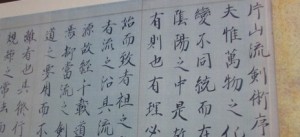 About Katayama-ryu Iai-kenjutsu
About Katayama-ryu Iai-kenjutsu
Katayama-ryu iai-kenjutsu is different from Hoki-ryu iaijutsu which is more widely known today. Katayama-ryu’s training differs from the usual iai training, which is performed individually using a real sword, and makes use of fukuro-shinai (a kind of bamboo sword) and bokuto (wooden sword) in partnered practice or with an iaidai (a wooden stand with three levels of differing height for striking).
Furthermore, in Katayama-ryu iai-kenjutsu, iai and kenjutsu are thought of as the same thing, with techniques beginning with the sword already drawn (kenjutsu) known as ihatsu and techniques beginning with the sword still sheathed in its scabbard (iai) known as mihatsu.
Katayama-ryu Iai-kenjutsu’s Techniques
In the Katayama-ryu Jomokuroku (the primary scroll of techniques for the school) the names of kata are recorded in the following groups, Omote Gokajo, Ura Gokajo, Ohen Hakkyoku, Iai Hakkyoku-hen and Tonomono. In normal training the Omote Gokajo, Ura Gokajo and Iai Hakkyoku-hen sets are performed using a fukuro shinai, while the Ohen Hakkyoku and Tonomono sets are performed using bokuto.The Omote Gokajo and Ura Gokajo sets are performed solo making use of an iaidai . The Omote Gokajo set is performed seated, using the lowest level of the iaidai. Training in the Ura Gokajo is done standing, making use of the middle and upper levels of the iaidai.
The Ohen Hakkyoku kata are ihatsu (kenjutsu) techniques starting with the sword drawn. The Iai Hakkyoku-hen kata are mihatsu (iai) starting with the sword sheathed in its scabbard. The Tonomono set contains both ihatsu and mihotsu kata.
Differences With Hoki-ryu Iaijutsu
Katayama-ryu kenjutsu training is performed in the above manner paired with a partner, with the exception of the Omote Gokajo and Ura Gokajo sets which use the iaidai. The more advanced practitioner (teacher or senior student) leads the training and is called aite, while the less experienced person who is training in performing the techniques is called tsukaite. In Katayama-ryu’s training, a real sword is not used. These characteristics differ completely from the training done today in the more widely known Hoki-ryu iaijutsu (Hoshino-ha) which focuses primarily on two sets of kata (Omote and Chudan) not contained in Katayama-ryu which are performed with real swords and without a partner.
The Rationale Behind the Term “Iai-kenjutsu”
In the old writings of Katayama-ryu it is recorded that “even though the Ohen Hakkyoku and Iai Hakkyoku-hen are called ihatsu and mihatsu, they are actually the same thing and indivisible.” meaning that there is no difference between iai and kenjutsu, so the term “iai-kenjutsu” is used to cover both. Further more, things like ” Mihatsu is called iai, Ihatsu is called heiho” (the term heiho was regularly used in place of kenjutsu in the Edo period), “Iai-heiho is one thing and there is not the slightest difference between the two.” and the like are written, showing that the fundamental thinking behind this school is that iai and kenjutsu are not separate entities, but rather the same thing, which is the reason for using mihatsu for iai and ihatsu for kenjutsu.




